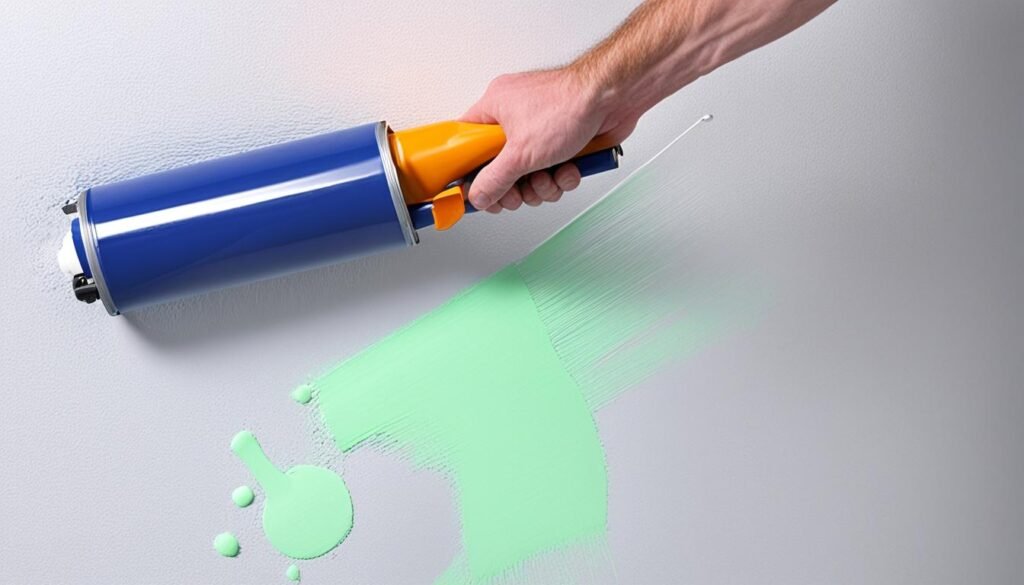Did you know that a staggering 70% of paint application errors occur due to drips and uneven finishes? Whether you’re a professional painter or a DIY enthusiast, achieving a flawless paint job can be a daunting task. But fret not! We’ve gathered the essential insider secrets that will help you achieve a smooth, drip-free paint application for your next project.
Key Takeaways:
- Mastering painting techniques is crucial for achieving professional results.
- Understanding color theory helps create visually appealing and harmonious color schemes.
- Proper surface preparation and using high-quality tools and materials are essential.
- Following time-saving techniques and the recommended painting order can save you time and effort.
- Find the best local drip-free paint services or professional painters near you for flawless finishes.
The Art of Mastering Painting Techniques
Mastering painting techniques is crucial for achieving professional results. It involves selecting the right paint colors and understanding how they interact on different surfaces. Professionals need to have proficiency in using the appropriate tools and application techniques such as cutting in, rolling, and spraying.
By mastering these techniques, painters can create personalized and welcoming spaces with flawless finishes, leaving a lasting impression on their clients.
When it comes to painting techniques, there are several methods that professional painters employ to achieve quality results. Let’s take a closer look at some of the most commonly used paint application techniques:
Cutting In
Cutting in refers to the carefully painted edges along walls, ceilings, and other surfaces that require precision. It involves using a high-quality paintbrush to create crisp lines and define the boundaries between different colors or sections.
Rolling
Rolling is a popular technique used to cover large areas quickly and efficiently. It is done using a paint roller, which allows for the even application of paint on walls, ceilings, and other flat surfaces. A roller cover with the appropriate nap length should be selected based on the texture of the surface being painted.
Spraying
Spraying is another technique that professional painters utilize for larger projects or surfaces that require a smooth, flawless finish. It involves using a specialized paint sprayer to evenly distribute the paint in a fine mist. Spraying is particularly effective for achieving a uniform coat on surfaces with textures or intricate details.
Mastering these painting techniques is a skill that requires practice and experience. Professional painters undergo extensive training to ensure they can achieve the best possible results for their clients. By understanding the nuances of each technique and selecting the most appropriate one for a given project, painters can consistently deliver impeccable finishes.
The Fundamentals of Professional Painting
Understanding color theory is essential for professional painters. It helps them create visually appealing and harmonious color schemes. Knowledge of the color wheel, color harmony, and the psychological impact of colors allows painters to evoke specific emotions and create the desired mood in a space.
When selecting colors, professional painters consider factors such as cultural preferences and region-specific color influences. By understanding the cultural significance of certain colors, painters can create spaces that resonate with the intended audience. They also take into account lighting conditions, as colors may appear different under various lighting sources.
Quality paint selection is paramount to achieving long-lasting and visually pleasing results. Professional painters rely on high-quality paints and finishes that offer durability, resistance to fading, and easy application. Trusted brands in the industry provide a wide range of paint options, ensuring the right fit for every project.
Finishes play a crucial role in the overall appearance of a painted surface. Professional painters are knowledgeable about the different types of finishes available, including matte, satin, semi-gloss, and high-gloss. They carefully select the appropriate finish based on the desired aesthetic and the practical needs of the space.
The Color Wheel and Color Harmony
The color wheel is a vital tool for professional painters. It organizes colors in a logical sequence, allowing painters to understand color relationships and create harmonious palettes. The primary colors of red, blue, and yellow serve as the base, from which secondary and tertiary colors are derived.
Color harmony involves the thoughtful combination of colors to achieve a pleasing and balanced composition. Professional painters utilize various color harmonies such as complementary, analogous, and triadic to create visually engaging spaces. These harmonies ensure that colors work together harmoniously rather than clashing or overpowering each other.

Cultural Color Preferences
| Culture | Color Preferences |
|---|---|
| Western | Neutral tones, cool blues, warm earthy colors |
| Asian | Red symbolizes luck and auspiciousness, yellow for prosperity, white for purity |
| Middle Eastern | Rich jewel tones, vibrant blues, and intricate patterns |
| Scandinavian | Light, airy pastels, muted tones inspired by nature |
| African | Earthy browns, vibrant yellows, bold patterns and prints |
Understanding cultural preferences ensures that professional painters create spaces that resonate with the intended audience and align with their cultural values.
Tips for a Perfect Paint Job
To achieve a flawless finish with drip-free paint near you, whether you’re a professional or a DIY painter, it’s essential to follow these expert tips and time-saving techniques. By implementing these painting tips, you’ll be able to complete your project efficiently and achieve professional-looking results.
1. Paint Preparation is Key
Start by thoroughly preparing the surface before applying any paint. This includes filling holes, sanding rough areas, and removing dust and debris. Take the extra time to ensure that the surface is smooth and clean. This will help your paint adhere better and result in a more even finish.
2. Properly Use Primer
Primer is a crucial step in achieving flawless finishes. It seals the surface, enhances paint adhesion, and ensures optimal coverage. Choose the right primer for your specific project, whether it’s for bare wood, metal, or previously painted surfaces. Apply primer evenly and allow it to dry completely before moving on to the paint application.
3. Invest in Quality Tools
High-quality paintbrushes and rollers can make a significant difference in the outcome of your paint job. Invest in brushes with smooth bristles that hold the paint well and provide precise control. Opt for rollers that have a dense nap for smooth and even application. Using the right tools will help you achieve flawless finishes with ease.
4. Follow the Recommended Painting Order
When painting a room, it’s important to follow the proper painting order. Start with the ceiling, then move on to the walls, and finish with the trim and baseboards. This sequence ensures that any drips or splatters from the ceiling or walls can be easily covered when painting the trim. Additionally, it allows for a more efficient and organized painting process.
5. Utilize Time-Saving Techniques
To save time and improve efficiency, utilize various time-saving techniques during your paint project. Mask off areas that don’t require painting to minimize touch-ups. Learn proper grip and loading techniques for your paintbrush and roller to maximize coverage and avoid fatigue. Additionally, use tools such as paint trays and roller grids for easier access to paint, reducing the time spent refilling.
6. Work in a Systematic Way
When painting a room, it’s essential to work in a systematic manner. Start from one corner and work your way to the opposite side, ensuring smooth transitions between painted areas. This approach helps you maintain a consistent application and create a cohesive look.

By following these painting tips and techniques, you’ll be able to achieve flawless finishes and professional-looking results. Whether you’re tackling a small DIY project or a larger-scale painting endeavor, these tips will help you save time, avoid common mistakes, and ensure a perfect paint job.
Conclusion
Achieving a smooth, drip-free paint application requires a combination of professional painting techniques, understanding color theory, using the right tools and materials, and following time-saving techniques. Whether you are a professional painter or a DIY enthusiast, mastering these insider secrets will help you transform spaces with flawless finishes.
Don’t settle for anything less than perfection when it comes to your painting projects. Instead, find the best local drip-free paint services or professional painters near you to achieve the desired results. By partnering with experts who offer drip-free painting solutions, you can ensure that your space is transformed with expert techniques and finesse.
With the right knowledge and resources at your disposal, you have the power to create visually stunning spaces that leave a lasting impression. Take advantage of the wealth of information available on painting techniques, color theory, and the latest tools and materials. Whether you are refreshing a room or undertaking a large-scale project, these insider secrets will empower you to achieve flawless results and elevate the aesthetics of your space.
FAQ
What are some professional painting techniques for achieving a smooth, drip-free finish?
Professionals should master cutting in, rolling, and spraying techniques for optimal paint application. These techniques ensure smooth and even coverage, minimizing the risk of drips or streaks.
Why is understanding color theory important for professional painters?
Understanding color theory allows professional painters to create visually appealing color schemes and evoke specific emotions in a space. It involves knowledge of the color wheel, color harmony, and the psychological impact of colors.
How can I achieve a perfect paint job?
To achieve a perfect paint job, start by thoroughly prepping the surface, including filling holes and sanding. Use primer to seal the surface and invest in high-quality paintbrushes and rollers. Follow the recommended painting order and utilize time-saving techniques such as masking off areas and using the right tools.
What are some time-saving techniques for efficient painting projects?
Time-saving techniques include masking off areas to avoid accidentally painting adjacent surfaces, using proper grip and loading techniques, and utilizing the right tools such as a paint sprayer for larger areas.
How can I find professional painters near me who offer drip-free painting solutions?
To find professional painters near you who offer drip-free painting solutions, you can search online for top-rated paint services or paint contractors. Read reviews, check their portfolio, and inquire about their painting techniques and guarantees to ensure you choose the best paint company for your project.

No comment yet, add your voice below!